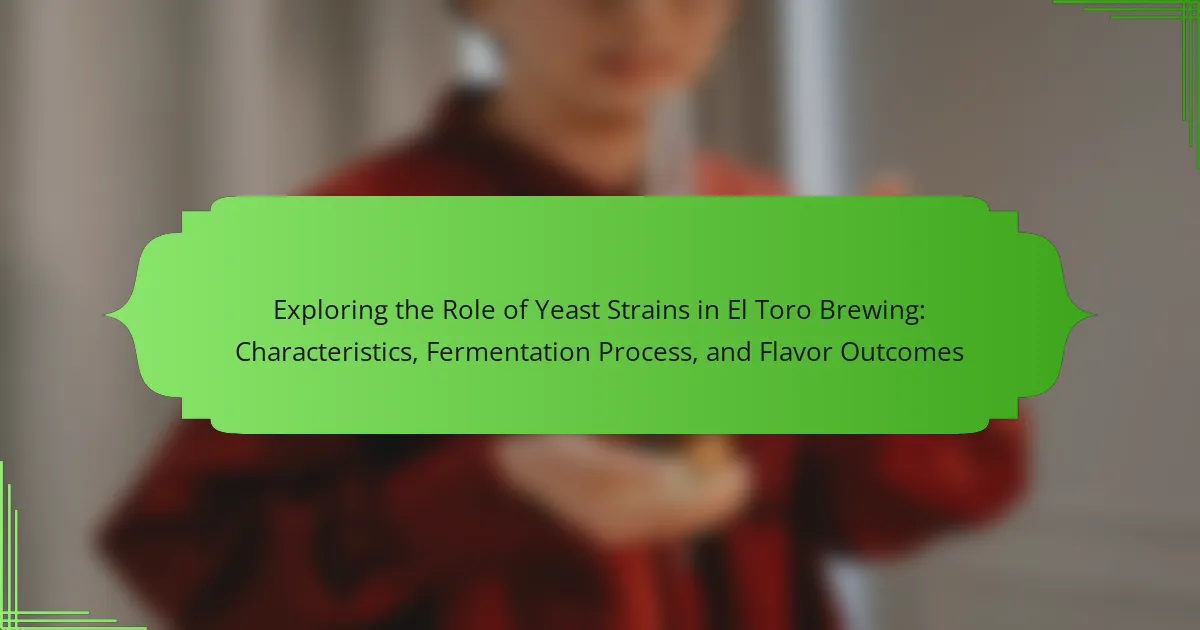Yeast strains are specific types of yeast crucial in the fermentation process of brewing, particularly at El Toro Brewing. These strains convert sugars into alcohol and carbon dioxide, significantly influencing the beer’s flavor, aroma, and overall quality. The article explores the fermentation process, highlighting how different yeast strains, such as Saccharomyces cerevisiae and Saccharomyces pastorianus, impart distinct characteristics to various beer styles. Temperature control during fermentation is emphasized as a critical factor affecting yeast activity and flavor profiles. Understanding the role of yeast strains is essential for brewers to achieve the desired taste outcomes in their products.

What are Yeast Strains and Their Importance in Brewing?
Yeast strains are specific types of yeast used in the fermentation process of brewing. They convert sugars into alcohol and carbon dioxide, which are essential for beer production. Different yeast strains impart unique flavors and aromas to the final product. For instance, ale yeasts typically ferment at warmer temperatures and produce fruity esters, while lager yeasts ferment cooler and create cleaner profiles. The choice of yeast strain can significantly influence the beer’s character and quality. Studies show that yeast selection can affect not only the taste but also the mouthfeel and aroma of the beer. Therefore, understanding yeast strains is crucial for brewers to achieve desired flavor outcomes.
How do different yeast strains influence the brewing process?
Different yeast strains significantly influence the brewing process. They affect fermentation speed, flavor profiles, and alcohol content. For instance, ale yeast ferments at warmer temperatures and produces fruity esters. Lager yeast operates at cooler temperatures, resulting in cleaner flavors. Specific strains also contribute unique aromas and taste characteristics. For example, Belgian yeast can impart spicy and fruity notes. Additionally, yeast health impacts fermentation efficiency and consistency. The choice of yeast can also determine the final beer clarity and mouthfeel. Overall, the selection of yeast strains is crucial for achieving desired brewing outcomes.
What are the key characteristics of various yeast strains?
Yeast strains exhibit distinct characteristics that influence fermentation and flavor profiles. Saccharomyces cerevisiae is known for its fast fermentation and ability to produce fruity esters. This strain is commonly used in ales and has a high alcohol tolerance. Saccharomyces pastorianus, used in lagers, ferments at lower temperatures and produces a clean, crisp flavor. Brettanomyces adds complex, funky flavors and is often used in sour beers. Kluyveromyces marxianus can ferment lactose, making it suitable for brewing with lactose-rich ingredients. Each yeast strain contributes unique attributes to the final product, impacting aroma, taste, and mouthfeel.
How do yeast strains affect fermentation rates?
Yeast strains significantly influence fermentation rates. Different yeast strains have unique metabolic pathways. These pathways determine how quickly yeast converts sugars into alcohol and carbon dioxide. For example, Saccharomyces cerevisiae is known for rapid fermentation. It can complete fermentation in as little as a week. In contrast, some wild yeast strains ferment more slowly, taking weeks or even months. The fermentation temperature also interacts with yeast strain characteristics. Higher temperatures typically accelerate fermentation for certain strains. However, some strains may produce off-flavors at elevated temperatures. Additionally, yeast health affects fermentation efficiency. Healthy yeast cells ferment more effectively than stressed ones. Therefore, selecting the appropriate yeast strain is crucial for optimizing fermentation rates.
What role do yeast strains play in flavor development?
Yeast strains play a crucial role in flavor development during fermentation. Different yeast strains produce distinct flavor compounds. These compounds include esters, phenols, and higher alcohols. Esters can impart fruity flavors, while phenols may add spicy or floral notes. The fermentation temperature also influences the flavor profile created by the yeast. For example, higher temperatures often lead to increased ester production. Additionally, yeast strains can contribute to mouthfeel and overall complexity. The choice of yeast directly impacts the final taste of the beverage. Research indicates that specific strains are preferred for particular styles of beer to enhance desired flavors.
How do yeast strains contribute to the aroma of the beer?
Yeast strains significantly contribute to the aroma of beer through the production of volatile compounds. These compounds include esters and phenols, which are key contributors to the beer’s fragrance. Different yeast strains produce varying levels of these compounds. For example, ale yeast typically generates more fruity esters than lager yeast. The fermentation temperature also influences aroma development. Higher temperatures tend to enhance ester production, resulting in a more pronounced aroma. Specific yeast strains are selected for their unique aromatic profiles. This selection process is crucial in crafting distinct beer styles. Research indicates that yeast strain choice can alter the overall sensory experience of the beer.
What are the flavor profiles associated with specific yeast strains?
Specific yeast strains produce distinct flavor profiles. For example, Saccharomyces cerevisiae often imparts fruity esters like banana and apple. This strain is commonly used in ales and can enhance complexity. Another strain, Saccharomyces pastorianus, is known for producing clean, crisp flavors typical in lagers. It reduces fruity esters, resulting in a more neutral profile. Brettanomyces, a wild yeast, contributes funky, earthy notes, often found in sour beers. Each yeast strain’s fermentation temperature also influences flavor outcomes. Higher temperatures typically increase ester production, while lower temperatures yield cleaner flavors. These characteristics highlight the significant role yeast strains play in brewing.

What is the Fermentation Process in El Toro Brewing?
The fermentation process in El Toro Brewing involves the conversion of sugars into alcohol and carbon dioxide by yeast. It begins after the wort is prepared and cooled. Yeast strains are then added to the wort in fermentation vessels. The fermentation typically lasts from several days to weeks, depending on the beer style. During this time, yeast consumes the sugars, producing alcohol and various flavor compounds. Temperature control is crucial throughout the process. It affects yeast activity and flavor profile. El Toro Brewing emphasizes specific yeast strains to achieve desired characteristics in their beers. This process is essential for developing the unique flavors that define their brews.
How does El Toro Brewing select its yeast strains?
El Toro Brewing selects its yeast strains based on specific flavor profiles and fermentation characteristics. The brewing team evaluates various yeast strains to determine their suitability for different beer styles. They consider factors such as attenuation, flocculation, and temperature tolerance. Each strain is tested in small batches to assess its impact on flavor and aroma. The results guide the selection process for larger production. This method ensures that each beer achieves the desired taste and quality. By focusing on these criteria, El Toro Brewing maintains consistency and excellence in its offerings.
What factors influence the choice of yeast for specific beers?
The choice of yeast for specific beers is influenced by several key factors. These include the desired flavor profile, fermentation temperature, and alcohol tolerance. Yeast strains contribute unique flavors and aromas, which are crucial for the beer’s character. For example, ale yeasts typically produce fruity esters at warmer temperatures. Conversely, lager yeasts ferment at cooler temperatures, resulting in cleaner flavors.
Alcohol tolerance is also significant; some yeast strains can withstand higher alcohol levels, which is essential for strong beers. Additionally, the yeast’s flocculation characteristics affect clarity and mouthfeel. Understanding these factors helps brewers select the appropriate yeast for their specific beer style, ensuring the desired outcomes in flavor and quality.
How does the fermentation temperature affect yeast activity?
Fermentation temperature significantly affects yeast activity. Higher temperatures generally increase yeast metabolism and fermentation rates. Optimal fermentation temperatures for most yeast strains range from 60°F to 75°F. At these temperatures, yeast efficiently converts sugars into alcohol and carbon dioxide. Temperatures above this range can lead to stress, producing off-flavors. Conversely, lower temperatures slow down yeast activity, potentially resulting in incomplete fermentation. Research shows that yeast activity can drop significantly below 50°F. This temperature sensitivity is critical for achieving desired flavor profiles in brewing.
What are the stages of fermentation at El Toro Brewing?
The stages of fermentation at El Toro Brewing include primary fermentation, secondary fermentation, and conditioning. During primary fermentation, yeast converts sugars into alcohol and carbon dioxide. This stage typically lasts from several days to weeks, depending on the yeast strain and beer style.
Secondary fermentation occurs after primary fermentation is complete. It allows for further flavor development and clarification. This stage can last from a few days to several weeks.
Conditioning is the final stage, where the beer matures and flavors meld. This process can take from a few weeks to several months. Each stage is crucial for achieving the desired flavor profile and quality of the final product.
What happens during the primary fermentation phase?
During the primary fermentation phase, yeast converts sugars into alcohol and carbon dioxide. This process typically lasts from a few days to several weeks. The yeast consumes the fermentable sugars present in the wort. As a result, alcohol levels increase while carbon dioxide is released. This phase is crucial for developing the beer’s flavor profile. The temperature and yeast strain significantly influence the fermentation rate and flavor outcomes. Monitoring these factors ensures optimal fermentation conditions. Primary fermentation is essential for producing the desired alcohol content and carbonation in the final product.
How does secondary fermentation enhance the final product?
Secondary fermentation enhances the final product by refining flavors and improving clarity. During this stage, yeast continues to consume residual sugars, resulting in a more balanced taste. This process also allows for the development of complex flavor profiles. Additionally, it helps in reducing unwanted byproducts like diacetyl, which can impart off-flavors. The removal of sediment during secondary fermentation contributes to a clearer appearance. Furthermore, it can enhance carbonation levels, leading to a more enjoyable mouthfeel. Overall, secondary fermentation is crucial for achieving a high-quality final product.

What are the Flavor Outcomes of Different Yeast Strains?
Different yeast strains produce distinct flavor outcomes in brewing. For instance, Saccharomyces cerevisiae typically imparts fruity and estery flavors. This strain is commonly used in ales. In contrast, Saccharomyces pastorianus is known for its clean, crisp profiles, often found in lagers. Belgian yeast strains can create complex, spicy, and phenolic flavors. These strains contribute to the characteristic taste of Belgian-style beers. Each yeast strain ferments sugars differently, impacting the final flavor. Temperature and fermentation conditions also influence these outcomes. Research indicates that yeast selection is crucial for achieving desired flavor profiles in brewing.
How do yeast strains impact the final taste of El Toro beers?
Yeast strains significantly influence the final taste of El Toro beers. Different yeast strains produce varying levels of esters and phenols. These compounds contribute fruity and spicy notes to the flavor profile. For instance, some yeast strains enhance banana or clove flavors. Others may produce a cleaner taste with minimal fruity esters. The fermentation temperature also affects yeast activity and flavor outcomes. Higher temperatures often lead to more pronounced fruity flavors. In contrast, lower temperatures can result in a crisper finish. The choice of yeast strain is crucial for achieving the desired beer style. Each strain brings unique characteristics that shape the overall sensory experience.
What specific flavors can be attributed to different yeast strains?
Different yeast strains produce specific flavors in brewing. For example, Saccharomyces cerevisiae often imparts fruity esters like banana and apple. This strain is commonly used in ales. In contrast, Saccharomyces pastorianus, used in lagers, tends to produce clean, crisp flavors with minimal fruity notes. Brettanomyces yeast can add complex flavors such as barnyard, leather, and spice. This strain is often used in sour and wild ales. Belgian yeast strains typically contribute spicy phenolic notes along with fruity esters. Each yeast strain’s unique metabolic pathways influence the flavor profile of the final product.
How does yeast strain selection affect the overall beer style?
Yeast strain selection significantly impacts the overall beer style. Different yeast strains produce varying flavors and aromas due to their unique fermentation characteristics. For instance, ale yeast typically ferments at warmer temperatures, resulting in fruity and estery flavors. In contrast, lager yeast ferments at cooler temperatures, producing crisp and clean profiles. The choice of yeast also influences the beer’s mouthfeel and body. Certain strains can enhance or diminish sweetness, affecting the perceived balance of the beer. Additionally, yeast can contribute to alcohol content and carbonation levels. Historical brewing practices demonstrate that yeast selection has shaped regional beer styles, such as Belgian ales with their distinct spicy notes. Overall, yeast strain selection is crucial in defining the style and character of the final product.
What are the best practices for using yeast strains in brewing?
Use healthy yeast strains for brewing to ensure optimal fermentation. Selecting the right strain is crucial for flavor development. Maintain proper fermentation temperatures for each yeast strain. This prevents off-flavors and promotes desired characteristics. Oxygen levels should be controlled during fermentation. Excess oxygen can lead to undesirable flavors. Pitch the correct amount of yeast based on the batch size. This ensures a healthy fermentation process. Regularly monitor fermentation progress to detect any issues early. Proper sanitation practices prevent contamination and maintain yeast health. Using a starter culture can improve yeast viability and fermentation efficiency. These practices enhance the overall quality of the brewed product.
How can brewers optimize yeast performance for desired flavors?
Brewers can optimize yeast performance for desired flavors by selecting specific yeast strains. Different yeast strains produce distinct flavor profiles during fermentation. Temperature control also influences yeast activity and flavor development. Higher fermentation temperatures often enhance fruity esters. Lower temperatures can produce cleaner, crisper flavors.
Nutrient management is crucial for yeast health and performance. Adequate nitrogen levels improve fermentation efficiency and flavor complexity. Oxygen levels should be monitored as well, as yeast needs oxygen for growth but not during fermentation.
Timing of yeast pitch affects flavor outcomes. Pitching at the right cell count ensures a healthy fermentation process. Lastly, fermentation duration can be adjusted to achieve desired flavor intensity. Each of these factors plays a significant role in the overall flavor profile of the final product.
What common challenges do brewers face with yeast strains?
Brewers commonly face challenges with yeast strains such as fermentation inconsistency, off-flavors, and contamination. Fermentation inconsistency occurs when yeast fails to fully ferment sugars, leading to variations in alcohol content and sweetness. Off-flavors can arise from stressed yeast, which may produce undesirable compounds like diacetyl or sulfur. Contamination by wild yeast or bacteria can spoil the beer, affecting taste and quality. Additionally, yeast health is crucial; poor cell viability can lead to sluggish fermentations. Temperature control is also vital, as extreme temperatures can inhibit yeast activity. These challenges can significantly impact the final product’s flavor and quality.
El Toro Brewing focuses on the critical role of yeast strains in the brewing process, highlighting their unique characteristics and impact on fermentation and flavor outcomes. The article details how different yeast strains, such as Saccharomyces cerevisiae and Saccharomyces pastorianus, influence fermentation rates, flavor profiles, and aroma development. It also outlines El Toro Brewing’s methods for selecting yeast strains based on desired beer styles, fermentation conditions, and the importance of maintaining yeast health. Additionally, the article addresses common challenges brewers face with yeast strains and best practices for optimizing yeast performance to achieve high-quality brews.


